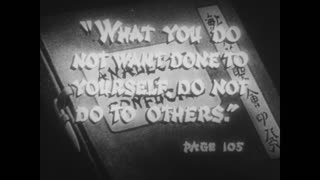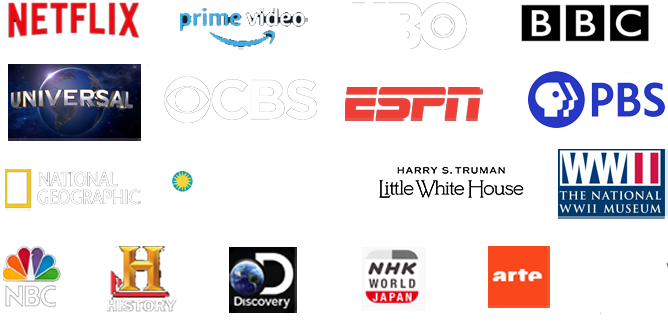“The Battle of China,” Chapter VI of Frank Capra’s “Why We Fight” series, explains why the Empire of Japan possessed such a strong interest in ruling the disparate lands of China. In an attempt to break the will of the Chinese people in one massive assault, Japan invades Nanking and massacres forty thousand civilians. The attack results in an opposite effect, galvanizing the Chinese resistance and unifying the separate lands into a single Chinese identity. While the Japanese take control of all Chinese ports, hoping to cut off all resources from its victim, China’s allies effectuate an engineering miracle. They construct the seven hundred mile long Burma Road over the mountains of Myanmar, and set up a constant caravan of trucks to ship food and materiel to the Chinese armies, keeping them alive. Frustrated by their inability to conquer China, the Japanese turn their attention to the islands of the Pacific, and the United States.
1:30 – 1:52: Introduction to the Battle of China, focusing on the onset of the Battle of Shanghai in September 1937, describing it as the beginning of a new kind of war with the first mass bombing of civilians.
2:02 – 2:13: Questions the rationale behind the bombing of innocent civilians by Japanese forces, leading into an exploration of Chinese history, culture, and significance.
2:21 – 7:13: Discusses the historical and cultural background of China, including its ancient history, vast geography, population, and contributions to civilization like printing, the compass, and gunpowder. Highlights China’s peaceful nature and philosophical contributions.
7:13 – 8:53: Shifts to the contemporary context where China is now an ally in war, explaining why Japan targeted China due to its land and population as part of the Tanaka Memorial’s plan for world conquest.
9:00 – 13:39: Contrasts the development paths of China and Japan, where China focused on modernization and education, while Japan built a military machine for conquest, detailing Japan’s military buildup and strategic violations of international treaties.
13:39 – 15:46: Details Japan’s initial conquests, starting with Manchuria in 1931, followed by the occupation of Jehol and the establishment of a puppet government, setting the stage for further expansion into China.
16:29 – 17:52: Discusses the Japanese strategy to prevent Chinese unification, leading to the Marco Polo Bridge Incident in 1937 as a pretext for further invasion.
17:52 – 20:14: Describes the Chinese counterattack at Shanghai, which was unexpected by Japan, and explains the strategic importance of Shanghai as a major port and commercial hub.
20:14 – 25:05: Narrates the brutal tactics used by Japanese forces in Shanghai, including the bombing of civilians and the introduction of terror warfare, with some finding refuge in foreign settlements.
25:05 – 29:55: Covers the fall of Nanjing (Nanking) after Shanghai, detailing the atrocities committed during the Nanjing Massacre, highlighting the deliberate cruelty by the Japanese forces.
29:55 – 36:31: Discusses the Chinese response to Japanese aggression, leading to national unity and a strategic retreat westward to preserve industrial and cultural assets, describing this massive migration as one of history’s greatest spectacles.
This summary captures the essence of the film’s narrative on the Battle of Shanghai and the broader context of the Second Sino-Japanese War, emphasizing both historical and cultural aspects of China alongside the war’s brutality and strategic developments.
Motion picture films don’t last forever; many have already been lost or destroyed. For almost two decades, we’ve worked to collect, scan and preserve the world as it was captured on 35mm, 16mm and 8mm movies — including home movies, industrial films, and other non-fiction. If you have endangered films you’d like to have scanned, or wish to donate celluloid to Periscope Film so that we can share them with the world, we’d love to hear from you. Contact us via the weblink below.
This film is part of the Periscope Film LLC archive, one of the largest historic military, transportation, and aviation stock footage collections in the USA. Entirely film backed, this material is available for licensing in 24p HD, 2k and 4k. For more information visit http://www.PeriscopeFilm.com


